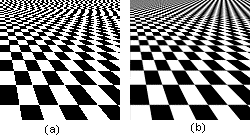| Geometric Transformation of Images |
Investigators: Stefan Horbelt, Maria Arrate Muñoz Barrutia |
|
Summary: We have designed a series of algorithms to implement geometric transformations of images in a way that minimizes the loss of information. The solutions are optimal in the least-squares sense. |
|
Geometric transformations play an important role in biomedical image processing. Image translations, rotations, and/or scaling, are required for data visualization, re-slicing of volumetric PET or MRI data sets, and image registration. The problem with most conventional interpolation procedures is that they produces noticeable artifacts (blocking, smoothing, and sometimes aliasing or ringing). Since image quality is a key concern, it is important to investigate techniques that result in less degradation.
The goal of this project is to develop new spline-based methods for implementing geometric transformations of images with the highest-possible quality. A special case of interest is the generation of a multiresolution representation of images (pyramids) for multiscale processing. Geometric methods are also very relevant for three-dimensional data visualization, and for texture mapping. Our algorithms are designed to be optimal in the least-squares sense, which is a principle that had not been used before in this particular context. |
|
 |
| Perspective texture mapping of a checkerboard pattern. (a) Point sampling of the source image; (b) new least-squares solution. |
We have proposed a new, iterative texture-mapping algorithm based on the idea of successive refinement. Our methods is optimal in a well-defined sense; it can deal with rather general (reversible) warping functions. Our new method compares favorably with the standard techniques in terms of image quality. It tends to produce sharper images while minimizing aliasing artifacts.
We have developed efficient algorithms for computing image pyramids (multiresolution approximation) that are optimal in the lp-norm. The case p = 1 was found to be of particular interest because it tends to simplify images while reducing ringing artifacts. |
|
Collaboration: Prof. Michael Unser |
|
|
|
[2] | S. Horbelt, P. Thévenaz, M. Unser, "Texture Mapping by Successive Refinement," Proceedings of the 2000 IEEE International Conference on Image Processing (ICIP'00), Vancouver BC, Canada, September 10-13, 2000, vol. II, pp. 307-310.
|
[3] | S. Horbelt, A. Muñoz Barrutia, T. Blu, M. Unser, "Spline Kernels for Continuous-Space Image Processing," Proceedings of the Twenty-Fifth IEEE International Conference on Acoustics, Speech, and Signal Processing (ICASSP'00), Istanbul, Turkey, June 5-9, 2000, vol. IV, pp. 2191-2194.
|
|
|
|
